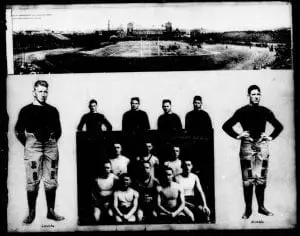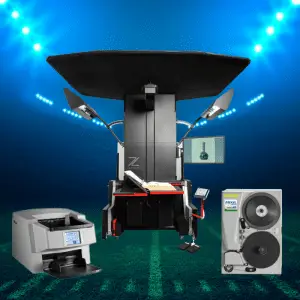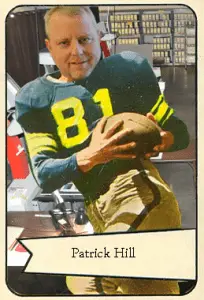Patrick Hill’s Digitization Playbook
Vince Lombardi. Coach from Cheers. Patrick Hill.
What do these people have in common? They’re born to coach a team (or, in the case of Cheers, a bar full of Bostonians. Same thing, right?).
In just nine months as Director of Crowley Imaging Services (Crowley), Patrick Hill has utilized his leadership, business and IT experiences to enhance the productivity and profitability of Crowley’s award-winning digitization service bureau. Coming into the fourth quarter of his first year, I sat with Hill to talk about his background, initiation into scanning and his digitization playbook for Crowley Imaging.
Rookie Starter To Utility Player
From Radford University (Va.) English major to business administrator to information technology guru, Hill’s career moves have made him an all-star problem solver. Case in point: At Hill’s first job as a business administrator, his company’s technology needs grew more quickly than their outside IT specialist could absorb. Hill followed the specialist, asked questions and picked up the slack where he could (like a true team player). Unexpectedly, he discovered a passion for the field and returned to school to earn several IT certifications.
In 1999, he officially joined the IT squad. Working as a network engineer and processes specialist within the healthcare, consulting and accounting fields, Hill gained his status as a utility player standout.
In 2006, Hill became the IT manager for Ruppert Landscape Company, a successful commercial landscape contracting business with branches throughout the United States. In this position, Hill was able to grow as a manager and use differing skill sets to create efficient internal processes to help grow the business. While in the service world, Hill realized the crucial role that well-rounded, trained and valued staff play in producing a good product or service. This concept would heavily influence his approach in the service bureau.
Hill first met another Patrick (Crowley, today’s company president) when their children attended the same school. Through years of high school sports and the accompanying fundraisers, he gained a general knowledge of Crowley’s business but wasn’t familiar with its specifics. When the director positioned opened last year, Hill saw an opportunity to work with a colleague, use his full skill set and learn something new.
Block and Tackle: Learning the Scanning Basics
While an expert in technology, eliminating the data knowledge learning curve, Hill still had to study the (micro)film (pardon the pun) on digital imaging. He leaned on his experienced team of scan operators to run his scanning training camp.
“Our team of imaging specialists has been invaluable in teaching me the nuances of each type of archival material and its capture,” shares Hill. “Having picked up just a portion of what the specialists know – from the best practices for microfilm scanning to capturing FADGI-level images and beyond – they’ve solidified my ideology that our operators are the cornerstone of everything we do. We have scan operators with decades of experience each; their insights and in-depth knowledge have been the basis of my education over the last few months.”

Coach Hill’s Playbook
Chatting with Patrick Hill about the service bureau reminds me of a post-game locker room interview. Instead of rows of wooden lockers, shelves of microfilm records, bound books and photo collections become the backdrop for his thoughtful and diplomatic analysis of “the game” – the challenge of running a successful conversion services bureau.
Here are a few key moves from Coach Hill’s playbook:
- Operate under a unified goal: “Providing a stellar product to our clients is the main objective. From our sales and contract teams to the project managers and scan operators, this goal unites us.”
- Know the score: “Open communication has made an early impact on how we’re working together toward the goal. I want to be transparent about where the company is headed and how we plan to get there. I had an influential person in my career tell me, ‘You’re going to play the game differently depending on what the score is.’ It is important for everyone on the team to understand our goals, the plan to accomplish these goals, where we are on the journey and how their individual strengths play into Crowley’s success.”
- Utilize special teams: “In most cases, the archives and records that we digitize are one of a kind. We recognize the extremely fragile nature of what we do and appreciate the high level of trust that is placed in our services. To ensure that trust is well-placed, Crowley operates with 50+ operators working two shifts on extremely detail-oriented work.
Additionally, we have imaging specialists that scan on-site when client security dictates that necessity. We have created groups of operators with specialized knowledge on specific media capture, such as photography, document or cultural heritage scanning, and who have become what I would deem experts. As the work comes in, we allocate it to these teams with the confidence that they fully understand each detail and can anticipate – and avoid – potential pitfalls.
This experience is not something we can replace and I believe it’s why we have so many repeat clients.”
- Promote diverse skills: “The types of projects that come in tend to shift. Our workload might be heavy in one area such as fragile archival documents or aperture card scanning one month and then shift to another type of scanning, like graphic arts scanning or loose paper capture the next month. We’ve put focus on cultivating a group of superstars that cross-train on a wide variety of scanners and camera systems as well as material types so that as the work type shifts, we can still maximize our labor efficiency.”
Pushing to the Goal Line
In just a few short months, the progress of Crowley’s high-performing digitization group is already measurable in the bureau’s latest productivity statistics. Like a good coach, this isn’t enough for Hill. He is constructing his next strategy while the field is still wet from his first Gatorade bath.
The next challenge for his team? According to Hill, it is staying ahead of technology (not unexpected from a former IT guy).
“Technological advancements will play a big factor in Crowley’s growth,” Hill predicts. “Over the next five years, I think new hardware and software developments will redefine what is possible for Crowley to accomplish in terms of speed and image quality and capturing the types of images our clients will be requiring. This is where I think Crowley is poised for success; as a manufacturer and service provider, we have the advantage to be at the forefront of crucial technology evolution for digitization.”
Hill also points out the evolution of image quality standardization as both a challenge and an opportunity. “As I’m learning, the adherence to imaging standards is becoming more stringent and is crossing more lines than ever before. Organizations such as the National Archives and the Library of Congress, which have had their own requirements, are now setting digital image and repository standards that can be followed by any organization with records or cultural heritage archives.
As end-users, we just want to find an image to copy and paste or quickly search text for easy access to a document that might be stored miles

away. An archivist or digital librarian has to also be concerned with both the permanence of the digital file – a nearly impossible task – as well as the accuracy of the digital image to the original. These evolving standards will provide the same playbook to all and level the playing ground, so to speak.
This is another area where I think Crowley will meet the challenge head on. With a variety of top scanning brands, such Mekel Technology, Zeutschel and InoTec, at our fingertips in the bureau and a color specialist in our technical services department, we are in a position to meet and grow with imaging guidelines as they evolve.
I’m excited about the opportunities of growth that are ahead of us.”
Keep Your Head in the Game with Crowley Imaging
We all know who the real commissioner in this digitization league is: time. No collection or person is free from its control. We salute those that contribute to the preservation of vital history including the archivists, librarians, records managers and other guardians of history.
Are you ready for a win against time? Crowley’s experienced imaging experts, well-rounded digitization solutions and network of industry professionals are on-hand to educate and support first-time and ongoing digitization projects with everything from book scanners to graphic arts scanners. Give us a call and we’ll work with Coach Hill to come up with a game plan that works best for your institution, collection, budget and desired end-result.
For more information on the conversion services offered by Crowley Imaging or the scanners that can be purchased for your own digitization efforts, please visit our website or call (240) 215-0224 or click here.
[Hannah-Clawson]

